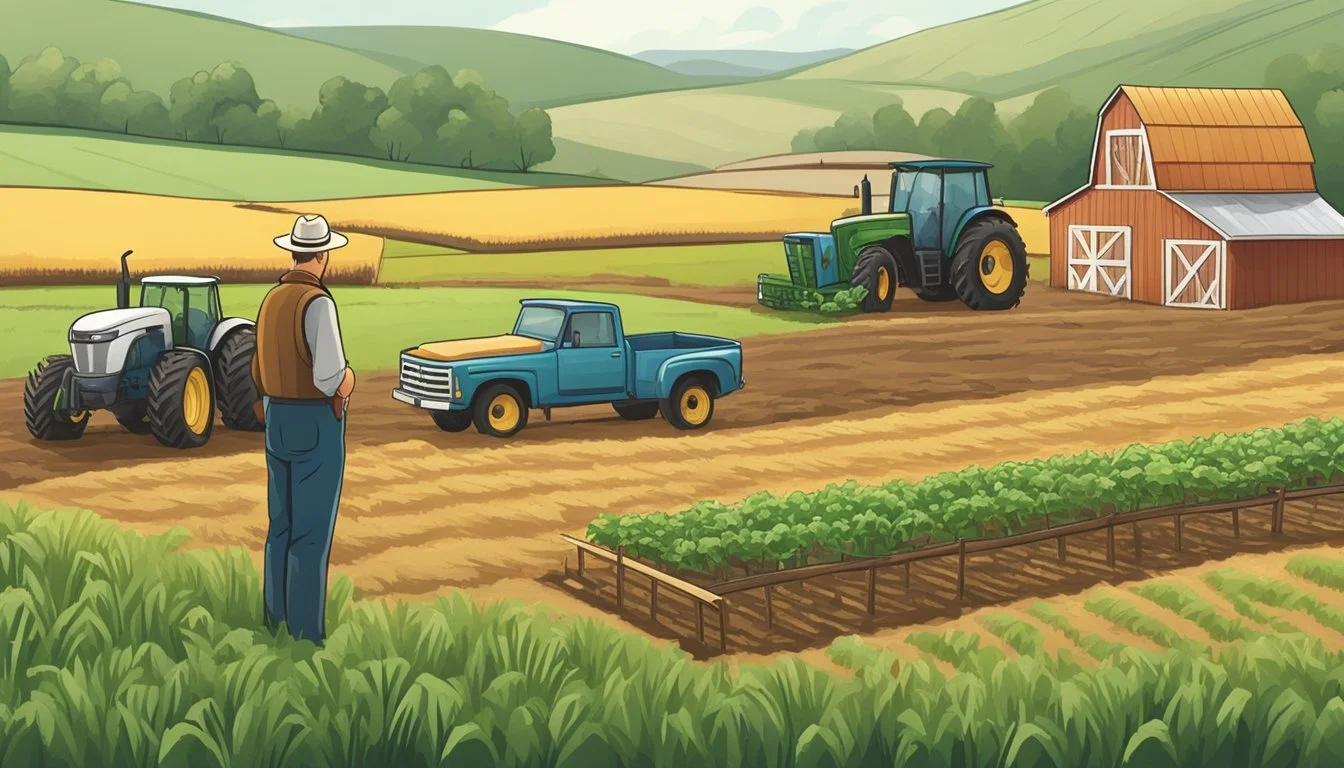Building Your Farm from the Ground Up
Essential Steps for Success
Starting a farm is not just a venture into the world of agriculture; it embodies the spirit of the American farmer—resilient, dedicated, and integral to the fabric of rural development. In the agricultural community, there is a wide variety of farm operations, ranging from small organic setups to larger farms with extensive machinery. Each type has its own set of challenges and rewards, but they all start with a clear vision and a solid business plan. Crafting these plans requires a deep understanding of the market, potential risks such as extreme heat or heavy rains, and the foresight to manage resources effectively.
With the support of various farm programs and services provided by institutions like the Department of Agriculture and local USDA service centers, aspiring farmers can find assistance to navigate the complexities of farm loans, pilot programs, and educational opportunities. Establishing a farm operation demands thorough business management skills, knowledge of crops and soil health, and an ability to weather the risks inherent to food production.
Farmers in the United States have access to a wealth of resources, from business loans tailored for agricultural endeavors to advice from seasoned farmers and agricultural experts. Whether considering a sole proprietorship or a larger business entity, understanding the fabric of the farm community and the available farm products is crucial. For those launching into this field, embarking on the journey of building a farm from the ground up is a testament to their commitment to both a way of life and the consumers who depend on their produce.
Choosing the Right Farm Type for You
When determining the most suitable farm operation, prospective farmers should consider market demands, personal interests, and the required resource management. The type of farm chosen will substantially impact both the business model and day-to-day activities.
Types of Farms to Consider
A variety of farm types exist, ranging from dairy farms to crop production and organic farming. Some farms, like larger farms, may have the capacity for diverse operations, whereas smaller ones might focus on niche markets. It's important to explore all options, including:
Specialty: organic, hydroponics, aquaculture
Conducting Market Research
Market analysis is crucial in understanding the agricultural community and rural development opportunities. Potential farmers should:
Review USDA service center offerings
Conduct market analysis for farm products
Assess the impact of environmental factors such as extreme heat or heavy rains
This research will inform which types of farms are in high demand and potentially profitable.
Evaluating Your Skills and Interests
Farming requires a diverse set of skills, from business management to a deep understanding of soil and food production. Farmers should assess their proficiency in various areas:
Business acumen for creating effective business plans
Technical knowledge of farming for producing high-quality crops or raising livestock
Adaptability to face risks like weather extremes
This self-assessment will help align personal strengths and interests with the right type of farm operation.
Obtaining Financing and Support
Securing financing and support for a farm operation encompasses a range of strategies, from navigating loans to leveraging government programs, all aimed at sustaining and advancing agricultural endeavors.
Exploring Loan Options
For many starting or expanding a farm, loans are a critical resource. Farm Ownership Loans, for instance, enable 100 percent financing, allowing farmers to purchase, expand, or improve their farms. When crafting a loan application, it is essential to have a solid business plan that addresses market analysis and business management, particularly for specialty types or larger farms, such as dairy operations or organic farming enterprises.
Making Use of Federal and State Programs
The U.S. Department of Agriculture (USDA) and various state-level entities offer a wide variety of farm programs designed to support the american farmer through different stages of farm development. To take advantage of these offerings, individuals should visit their local USDA Service Centers, which provide assistance, resources, and sometimes even educational opportunities to help navigate through everything from pilot programs to disaster assistance catering to risks such as heavy rains or extreme heat.
Federal Programs
Farm Service Agency (FSA): Offers resources ranging from beginner farmer loans to conservation programs.
Natural Resources Conservation Service: Provides technical assistance and funding for soil and crop management.
Fish and Wildlife Service: Supports land conservation efforts for long-term sustainability.
State Programs
Often tailored to specific state agricultural priorities and available resources.
Building an Agricultural Community
Engagement with the agricultural community is not only about obtaining support but also about contributing to rural development. Participating in local farming groups or cooperatives can offer mutual benefits, such as shared knowledge on resource management, networking opportunities, and a platform for advocating the interests of farms and ranches of every size and focus, including business entities or sole proprietorship ventures. This community involvement helps to fortify producers against the unpredictable nature of farming in the context of climate and market variability.
Creating a Business Plan and Structure
Crafting a robust business plan and choosing the right structure for your farm are critical steps in setting a solid foundation for your agricultural venture. The process involves a careful consideration of the unique aspects of farm operation, adherence to legal business structures, and meticulous planning to handle the myriad challenges of farming.
Choosing a Business Entity
When establishing a farm, selecting the appropriate business entity is crucial as it impacts taxes, liability, and management operations. Sole proprietorship is common among small, family-owned farms due to its simplicity, but it comes with personal liability. Partnerships are similar but involve shared ownership. For those seeking to protect personal assets, creating a Limited Liability Company (LLC) or a Corporation can provide liability protection. Larger farms or those seeking external investment may consider these structures. The Farm Service Agency offers assistance, including farm loans for various types of entities.
Developing a Business Plan
A business plan serves as a roadmap for both new and seasoned farmers. It should articulate a clear vision for the farm and include:
Market Analysis: Assess demand for farm products, understand the agricultural community, and identify potential customers.
Types of Farms: Clarify whether engaging in dairy farming, organic farming, ranching, etc., as each has unique needs and market opportunities.
Farm Programs: Explore USDA service centers and Department of Agriculture for pilot programs and resources.
Risk Management: Plan for the inherent risks in farming, such as extreme heat or heavy rains, affecting crops and livestock.
Farm business plans are dynamic documents that adapt to the changing agricultural sector.
Managing the Business Side of Farming
Effective business management requires:
Financial Planning: Utilize resources like business loans for rural development and understand the cost of soil enhancement, feed, and labor.
Educational Opportunities: Take advantage of programs that offer educational opportunities in business management and agricultural practices.
Resource Utilization: Utilize tools, such as farm operation software, for efficient management.
Connections: Build relationships with the broader agricultural community for support and knowledge sharing.
Managing a farm's business aspect necessitates a commitment to ongoing learning and adaptation to the evolving landscape of American farming.
Overcoming Farm Challenges
Building a successful farm involves navigating a landscape of challenges. Resilience and informed decision-making are vital for farmers who must cope with environmental, financial, and educational hurdles.
Dealing with Weather Extremes
Farmers must adapt to weather extremes, such as heavy rains or extreme heat, which can detrimentally affect crops and livestock. Proactive soil management is essential in protecting against erosion and nutrient loss. Utilizing USDA service centers, farmers can access resources and pilot programs that may offer assistance in weatherproofing their operations. For instance, crop diversification and investing in irrigation systems can mitigate the impacts of unpredictable climates on a farm’s profitability.
Managing Risks and Uncertainties
Risks in farming range from market volatility to equipment failure. Smaller farms and even larger farms can reduce risks through:
Business Plans: Detailing a comprehensive strategy that outlines the farm's goals, including market analysis and resource management.
Insurance: Accessing programs from the Farm Service Agency or other agencies that provide cover for crop loss or price drops.
Diversification: Implementing a variety of farm products or types of farms to spread and mitigate risk.
Seeking Educational Opportunities
Educational opportunities are fundamental for both seasoned farmers and newcomers in strengthening their understanding of farm operation and business management. Many government agencies, including the Department of Agriculture, offer training in organic farming, rural development, and other sectors. They can aid in crafting a solid business entity, whether a sole proprietorship or a larger organizational structure. Taking advantage of workshops, extension programs, and online resources fosters a well-informed agricultural community.





